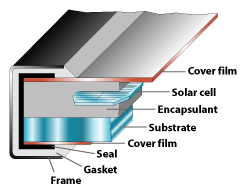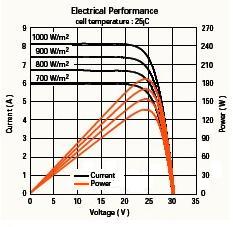SOLAR PANELS FOR HOME USE: FACTS and INFORMATION

The term “solar panel” in general refers to any complete environmentally protected device that absorbs sunlight and converts it into a more usable form of energy, such as electrical or thermal. This term is used interchangeably with the term "module". In this case, panel may refer to a collection of modules mounted together as a field installable unit. The two main types of solar modules that you can use in your home are photovoltaic panels, which generate electricity, and solar thermal collectors, which convert solar energy into heat. Here you will find basic facts and practical information on photovoltaic (PV) devices.
HOW MODULES ARE MADE
A PV module normally consists of one or more strings of series-connected photovoltaic cells assembled in a support structure (see the diagram below).
 A structure of a typical flat-plate solar panel (courtesy of EERE)
A structure of a typical flat-plate solar panel (courtesy of EERE)
The structural support is often provided by a frame in the back and around the outer edges, usually aluminum. Some manufacturers, such as First Solar, use frameless laminate designs. The cells as well as the top and rear surfaces are held together by an optically transparent encapsulant, such as Ethyl vinyl acetate (EVA). The transparent front surface normally has an anti-reflection coating that reduces the reflection of sunlight.
The commercial modules intended for home use usually provide a junction box in the back. It connects to two waterproof cables equipped with lockable connectors. The cables should have marks of the positive and the negative polarities, although usually red is plus and black in minus.
HOW DO THEY WORK
When light hits the PV cells inside the structure, it creates voltage across each cell of not more than 0.5 to 0.7 volts. In this process, a portion of radiated solar energy is converted into electrical energy. Individual cells are connected in series inside the module, which adds up the voltage. Some manufacturers also parallel two or more series strings to achieve higher currents. See series and parallel connection methods for more details. Different brands and models may have different number of cells. In the commercially available devices, the open circuit voltage Voc is typically between 30V and 100V. When no load is not connected to the module, the circuit is open; there is no current flow and therefore no power transfer. When an external load such as a battery charger or an inverter is connected to the panel's terminals, it closes the circuit. The free electrons driven by the electric field (described by voltage) can now flow from the minus terminal to the plus terminal through this external circuit. Such a flow of electric charges is called electric current. Although it is electrons which produce current in conductors, there is an old convention to consider the direction of the current as if it were the positive charges which are moving. So, we take the direction of the current from plus to minus.
As the electrons flow through a load, they perform work and their potential energy is converted to some other form. Thus, converted solar power is being delivered to the load.
UNDERSTANDING THE SPECIFICATION

The diagram on the right shows as an example volt-amp characteristics of Mitsubishi 185W module PV-SUD185MPH5. The output voltage is the highest at no load- it's about 30V. When any panel is loaded, initially its output slightly drops as a function of the current. At some point, the voltage drops to zero and current can no longer increase. This maximum value is called short circuit current (Isc). In our exampe Isc is between 6 and 8 A depending on the illumination intensity.
Note that power in watts equals to voltage times current: P=VxI. The maximum amount of power generated by a cell is somewhere near the knee of its V-I characteristic, as you can see from the diagram. In our case it is up to 195 W. In general, for your home system you want to choose the model that provides maximum wattage per dollar. Of course, you also need to get the right voltage that matches your batteries (if any) and inverter. Note that Voc depends on the properties of PV cell materials and the temperature, but practically does not depend on the intensity of the light. The short circuit current in contrast is also a function of the sunlight. Finally, the actually generated power being product of V and I depends on the temperature, amount of sunlight and the load.
